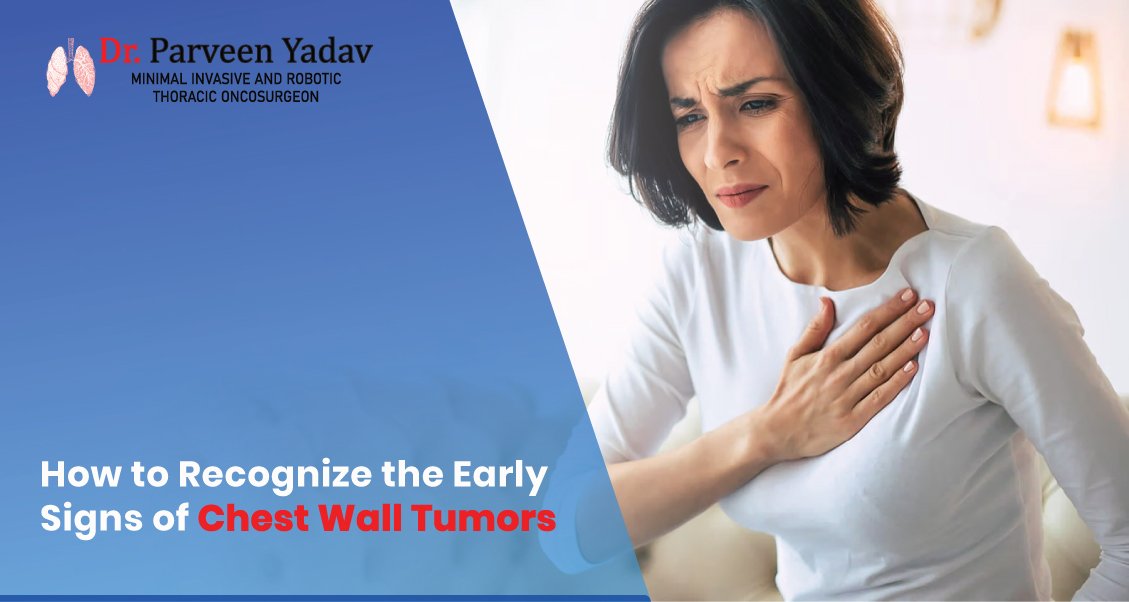
How to Recognize the Early Signs of Chest Wall Tumors
Chest wall tumours, though uncommon, can be concerning for patients due to their location and potential impact on nearby organs, including the lungs and heart. Early detection is important for timely intervention and better outcomes. This article seeks to guide readers through the initial signs, symptoms, and diagnostic tools used to identify chest wall tumours, enabling individuals to seek medical care when necessary.
What Are Chest Wall Tumors?
Chest wall tumours can be either benign (non-cancerous) or malignant (cancerous) and develop in the muscles, bones, cartilage, or connective tissues of the chest. They may also originate from nearby structures and metastasize to the chest wall.
- Primary tumours arise directly from the chest wall tissues.
- Secondary tumours are the result of cancer spreading from other parts of the body to the chest wall.
Types of Chest Wall Tumors:
- Benign: Lipomas, fibromas, chondromas.
- Malignant: Sarcomas (osteosarcoma, chondrosarcoma, or Ewing's sarcoma) and metastases from cancers like breast or lung cancer.
Early Warning Signs and Symptoms of Chest Wall Tumors
Recognizing the early signs of chest wall tumours is essential to differentiate them from other benign conditions, such as muscle strain or infections. Some symptoms may initially seem mild but should not be overlooked.
1. Persistent Chest Pain
- One of the earliest signs of chest wall tumours is localized, dull, or sharp pain in the chest area.
- Pain may worsen over time or with movement, breathing, or physical exertion.
- Unlike everyday muscle aches, this pain often persists despite rest or over-the-counter pain relievers.
2. Visible or Palpable Lump
- A noticeable lump or swelling on the surface of the chest is a common indicator.
- The lump may feel firm, soft, or rubbery, depending on the type of tumour.
- In some cases, the lump may increase in size over weeks or months.
3. Swelling and Redness
- Swelling around the tumour site, often accompanied by skin redness or warmth, can occur.
- This may suggest infection-like symptoms, but if swelling persists without infection, it requires further investigation.
4. Restricted Movement and Stiffness
- Chest wall tumours can cause stiffness in the chest, making it difficult to move freely.
- Movement of the arms or upper body might feel restricted, especially if the tumour is close to the ribs or muscles.
5. Breathing Difficulties
- Tumors located near the lungs may interfere with normal breathing, causing shortness of breath or discomfort during inhalation.
- Patients may feel like their chest is tightening, particularly if the tumour exerts pressure on the lungs.
6. Unexplained Weight Loss and Fatigue
- If the tumour is malignant, general signs like unexplained weight loss, persistent fatigue, or loss of appetite may occur.
- These systemic symptoms often indicate that the body is under stress due to cancer growth.
7. Recurrent Chest Infections
- Some tumours may press against the lungs, leading to frequent respiratory infections or pneumonia-like symptoms.
- This is particularly common when tumours grow internally and affect the airways.
Medical Imaging and Diagnostic Tests
If early signs suggest the presence of a chest wall tumour, medical professionals employ diagnostic tools to confirm the diagnosis. Timely imaging can help detect tumours early, facilitating better treatment outcomes.
1. Physical Examination
- A healthcare provider will first palpate the chest to identify lumps, tenderness, or restricted movement.
- The patient's medical history is reviewed to check for any previous illnesses or risk factors, such as family history of cancer.
2. X-Ray Imaging
- Chest X-rays are usually the first imaging test performed to detect abnormal growths in the bones or soft tissues of the chest wall.
- They help determine the size and position of the tumour.
3. Computed Tomography (CT) Scan
- CT scans deliver a clear cross-sectional view of the chest, enhancing clarity regarding the tumor's size and extent.
- CT scans are particularly helpful in evaluating whether the tumour has invaded adjacent tissues or organs.
4. Magnetic Resonance Imaging (MRI)
- MRI scans provide high-resolution images of soft tissues, making them ideal for assessing tumours in muscles, cartilage, or connective tissues.
- MRI also helps determine the tumour's interaction with nearby structures.
5. Biopsy and Histopathological Examination
- If imaging reveals a suspicious mass, a biopsy may be conducted to extract a tissue sample.
- The sample is analysed under a microscope to verify whether the tumour is benign or malignant.
Examples of Common Chest Wall Tumors and Their Symptoms
1. Osteosarcoma
- A malignant bone tumour commonly affects the ribs.
- Symptoms: Severe localized pain and swelling, often worsening at night.
2. Chondroma/Chondrosarcoma
- Tumours arise from cartilage, which can be benign or malignant.
- Symptoms: Firm lumps and pain aggravated by physical activity.
3. Lipoma
- A benign, fatty tumour that forms just below the skin.
- Symptoms: Painless lump, usually soft and slow-growing.
When to See a Doctor?
It is important to seek medical attention if you experience any of the following:
- Persistent chest pain lasting more than two weeks.
- A lump in the chest that continues to grow.
- Difficulty breathing or frequent chest infections.
- Unexplained weight loss or fatigue.
Prompt medical evaluation ensures that tumours are detected early, increasing the chances of successful treatment.
Final Words
Recognizing the early signs of chest wall tumours is critical for timely diagnosis and treatment. Persistent pain, palpable lumps, and breathing difficulties are some of the key symptoms to watch out for. Diagnostic imaging tools like X-rays, CT scans, and MRIs play a vital role in identifying tumours early, while biopsies confirm their nature.
While not all chest wall tumours are malignant, early intervention provides the best opportunity for effective treatment. If you detect any concerning symptoms, do not delay consulting a healthcare professional. Timely diagnosis can significantly improve outcomes and ensure a better quality of life

